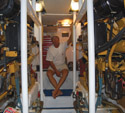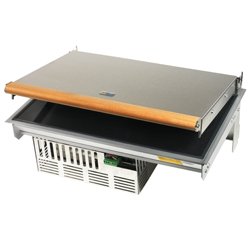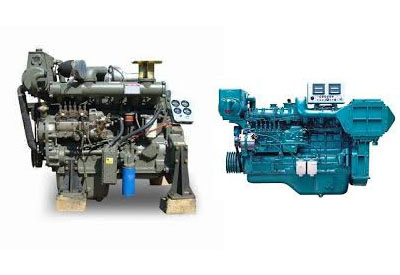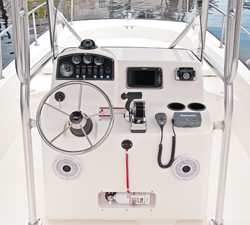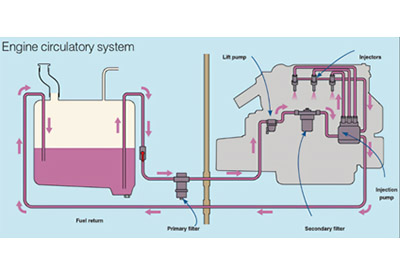Care and Feeding of Your Control Cables
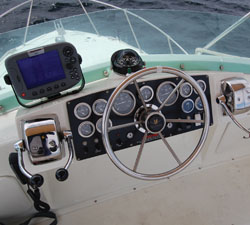
We’ve all seen it, or worse, had the experience ourselves; an older boat making a less than elegant landing due to sticky throttle cables, or stiff, balky steering. There are lots of older boats out there that get less use than they deserve due to old and uncooperative cables.
This is confirmed by the amount of discussion on various chat rooms concerning the problems associated with cables. Assuming your engine is in good working order, your steering and control cables are the next most important systems on your boat. Yet so often we see boats where these cables are poorly installed or corroded.
If you are having trouble with control or steering cables, the worst thing you can do is nothing. The problem will not resolve itself, but will only get worse and eliminate any chance of restoring the cable. A few simple precautions can make the difference between boating enjoyment and boating misery.
1) Start by checking the outer jackets on all cables for cracks. The problems come from various sources. In some older cables, UV rays can cause the outer jacket to crack allowing water to cause internal corrosion. Once this has happens, replacement is your only option.
2) Cables should be in a clean and sheltered area if possible. It sounds obvious, but be sure they are not being stepped on. This usually happens at the engine well.
3) Be sure there are no turns with a radius tighter than the manufacture minimum bend radius: 8” bend radius for solid wire core and 4” bend radius for TFXTREME.
4) Where the cables leave the control unit you should try to have at least a 1.5 foot straight run before any bends.
5) Also be sure there is enough slack at the motor end to allow for the engine turning.
6) All cables are internally lubricated, but the ends can become corroded. Make sure they are clean and free of corrosion
It is impossible to predict the life expectancy of steering or control cables due to the wide range of operating conditions in which they are used. These can vary from a few weekends a year in a northern freshwater lake, to year-round use in the warm, salty waters of south Florida. If your cables restrict or compromise your ability to control the boat, major manufacturers such a Teleflex Marine have connection kits that should allow retrofitting motors from the 1980s, 1970s and even older.
The compromise with cables has always been between having a tight core for precise response and a loose core which gives a smoother feel. However, in longer or more complicated runs the tight core becomes stiff and the loose core becomes sloppy. In reaction to these issues and to meet customer expectations, Teleflex Marine has come out with their TFXTREME technology. These cables utilize a patented splined core. The company claims these ridges allow a close fit with the inner liner but with less friction, resulting in very smooth and precise operation.
Steering Cables Steering You Wrong?
As with control cables, you shouldn’t wait until you have steering problems before doing some preventative maintenance on your boat’s steering cables. If the steering is stiff, this is a sign the system needs attention. Indeed, forcing the steering will just shorten the life of the cable. Steering cable maintenance is recommended at least twice a year and includes inspecting for signs of stiffness, binding, excessive free play and/or wear. These items cannot be repaired; if any components are not in good working order, replace them. Always replace steering cables that are stiff in operation or have damage to the plastic jacket. The interior of the cable is lubed for life however, particularly in salt water, corrosion can tighten the cable in the engine through tube.
Follow these steps to clean and lubricate the engine tilt tube or cable support tube and the steering cable telescopic output ram.
1) Remove the steering cable(s) telescoping ram from the tilt tube
2) Clean the tilt tube inside diameter thoroughly
3) Remove corrosion in the tilt tube with a wire brush and wipe until all loose material is removed.
4) Lubricate the tilt tube with a good water resistant marine grease.
5) Clean the steering cable telescopic ram with a brass wire brush and wipe clean.
6) Lubricate the sliding parts of the telescopic ram with high-quality, water resistant marine grease.
7) Reassemble, making sure all the correct fasteners are tight and there is no binding or excessive free play in the moving parts.
If you are re-powering an older boat, it is important be make sure the steering systems is properly matched to the engine. Teleflex, for example, sells both rotary and rack and pinion systems which are available with a no-feedback feature to eliminate the effect of engine torque. Your steering system is no place to compromise.
Today, replacement steering and control cables are simple and reliable. And, not that expensive, especially considering the cost of a docking disaster, or a sea tow due to a throttle problem out on the water. With some basic attention, there is no reason your old boat should not be a pleasure to operate.
By Glen Cairns

